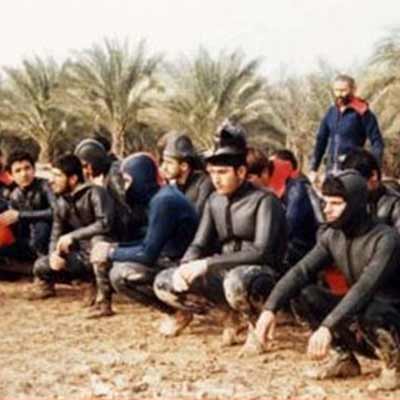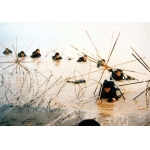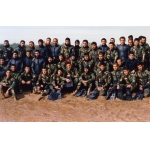Operation Karbala-4
Azamsadat Hosseini
632 بازدید
The Ground Forces of the Islamic Revolution Guards Corps designed and implemented Operation Karbala-4 in 1986, in the west of Arvandroud (south of Khorramshahr), in the operational area of Shalamcheh.
After the implementation of Operation Fajr-8 at the end of 1985 and with its success, the authorities of the Islamic Republic decided to coordinate and mobilize all the forces and facilities of the country to carry out a wide-scale operation and finish the war. Therefore, 1986 was called the year of the “fate of war”. A major operational design in Abul Khasib and east of Basra had been on the agenda of the IRGC since the beginning of this year. The final tactical plan of this operation was approved in the meetings held on September 25, 26 and 27, 1986.[1] This operation was called the “fateful operation”.[2]
The area of Operation Karbala-4 was determined in the southwestern part of Iran and southeastern Iraq, in the operational area of Shalamcheh. This area is located in the southeast of Basra and it is limited to the Zayd River from the north, Khorramshahr from the east, Arvand and Arvand Saghir Rivers from the south, and the Zozi Channel and the cities of Tanumeh and al-Haritha from the west.[3]
The objectives of this operation were to create a superior political and military position for Iran, to destroy Iraqi forces in the western region of Arvand, to respond to Iraqi attacks on residential areas, to capture the positions from where Iraq was firing on the cities of Abadan and Khorramshahr, to approach Basra and its facilities, capture Iraq's sensitive ports and the Abul Khasib region, to siege the forces stationed in the Faw Peninsula and to neutralize the threat of Basra from the south.[4]
The Revolutionary Guards requested 1,500 battalions of troops to attack the Iraqi forces from the three regions of Hur, East Basra, and Abul Khasib.[5] It was not possible to provide this number of troops (about 450000), so, three hundred battalions were prepared for this operation. The troops were organized under the title of Muhammad Corps and, after gathering at the Azadi Stadium in Tehran, they were sent to the target area on December 2, 1986.[6]
After ten months of effort and mobilization of the country's facilities, extensive propaganda to determine the fate of the war, and in a situation where the country's industrial, economic and utility centers were targeted by the heavy bombing of Iraq, the operation was ordered.[7] Noah's four camps (to secure the left flank and advance in front of Mino Island), Karbala (to confront the enemy's camp in front of Umm al-Rasas Island and advance to the surrounding roads and secure the entire operation area), Quds (to cross the strait and advance into the petrochemical areas and Abul Khasib) and Najaf (for the operation in the north of the pentagonal area in Shalamcheh to the islands of Bowarin and Umm al-Tawila) of the IRGC were responsible for the implementation of this operation. Several units of the army's ground forces were also in the front lines and the army's air force was involved in supporting the operation.[8]
Before the announcement of the operation code, at 21:00 on December 24, 1986, the divers were released into the Armand River in the axis of the Quds Base. But the enemy forces placed them under heavy fire.[9] The evidence showed that Iraq was aware of the operation and had blocked the most important passage of the operation, i.e. the two narrow sides of the Umm al-Rasas Waterway, which was referred to as the operation strait.[10] Of course, due to the immobility of the enemy in the axes of Noah, Karbala, and Najaf, the conditions seemed normal.[11]
The operation started at 22:30 on December 23, 1986, with the codename “Ya Muhammad”.[12]
Iraq's vigilance did not rely solely on observing the movements of Iranian forces, but relied more on information received from the American spy system.[13] This cooperation was disclosed by American officials at the height of the dispute between the United States and Iraq over the occupation of Kuwait by the Iraqi army in the late 90s.[14] The Iraqis called their confrontation with Operation Karbala-4 as the "Great Day Battle”.[15]
With the start of the attack, the forces advanced and captured targets in the axis of Najaf, Quds, Noah and Karbala. However, on Beljaniyeh Island, in the axis of the Karbala Base, the 14th Imam Hussein Division could not disembark their troops. The Quds Base did not succeed in clearing the tip of Mahi Island, but the forces of the Karbala Base succeeded in advancing on Umm al-Rasas Island. The situation in the Shalamcheh area was better and from the units under the command of the Najaf Base, the 19th Fajr Division was able to enter Panjzla'I, while the 57th Abul Fazl Division also succeeded in advancing. On Mino Island, the 33rd al-Mahdi Brigade from the Noah Base was able to join the 32nd Ansar al-Hussein Brigade from the Karbala Base. The 7th Vali Asr Division was also able to enter Sohail Island from the Noah Base.[16]
At 02:10. on December 25, the conditions of the Ansar al-Hussein Brigade from the Karbala Base and the 33rd al-Mahdi Brigade from the Noah Base was reported to be unfavorable. After that, the 8th Najaf Division from the Karbala Base was also in a very difficult situation. At 03:17, the 7th Vali Asr Division, from the Noah Base, announced that it was not possible to clear a part of Sohail Island. In other camps, the situation was also not favorable and the desired result was not achieved.
In this operation, the Iraqi defense line was broken in Shalamcheh for the first time, but it was not possible to continue for Iran the operation.[17] Due to the situation of the forces and the failure to achieve the goals, an order to stop the operation was issued at 23:45 on the December 26, 1986.[18]
Among the many factors that determined Operation Karbala-4, two were more decisive than others: 1. the disclosure of the operation by information received from the American spy agency and 2, Iraq's experience gained from their loss in Operation Fajr-8, which was successfully carried out by the Iranian forces in Faw.[19]
By emphasizing the scope of this operation was to capture Basra, the Iraqis intended to exaggerate its victory, even though Operation Karbala-4 was part of a large-scale operation in terms of its goals, but, because the time of the conflict was limited, it was decided to cut it short. Furthermore, within the military-political circles, it was not considered to be Iran's final large-scale operation.[20]
In Operation Karbala-4, 985 people from the Iranian forces were martyred and 8071 people were injured.[21]
After the objectives of Operation Karbala-4 were not achieved, Operation Karbala-5 was designed and implemented on January 9, to maintain the political-military superiority of the war in favor of the Islamic Republic of Iran and to deal with the stagnation in other battle fronts.[22]
At the end of May 2014, the bodies of 175 divers from Operation Karbala-4, who were examined in the Iraqi village of Abuflos, were transferred to Iran.[23] According to the evidence, while most of them were wounded, these fighters were captured by the enemy before the front line, and their bodies were buried in a mass grave with their hands, and sometimes their feet, tied.[24]
On the anniversary of Operation Karbala-4 in 2017, Mohsen Rezaei, the secretary of the Expediency Council and former commander of the Islamic Revolutionary Guard Corps, wrote that Operation Karbala-4 was carried out to distract the enemy.[25] There were different reactions to this article, and Mohsen Rezaei responded to them by saying that he meant that 24 hours after the start of the operation, this operation turned into a distraction operation. Also, General Qasim Soleimani, the commander of the 41st Tharullah Division in Operation Karbala-4, said that it was after the implementation of Operation Karbala-5 that Operation Karbala-4 became a distraction operation in the enemy's mind.[26]
The memorial to the martyrs of Operation Karbala-4 has been established in the operational area next to Arvandroud. In it visiting by many during the Rahyaan-e- Noor tours.[27]
[1] Ansari, M., Fawzi, Y., Lotfollahzadegan, A., Iran-Iraq War Chronicle, Book 44: McFarlane's Story, Tehran: Islamic Revolution Guards Corps War Studies and Research Center, 2001, p. 19.
[2] Ibid, p. 21.
[3] Pourahmad, A., The geography of the lasting operation of the holy defense, Tehran: Foundation for the preservation of the works and values of the holy defense, 2007, p. 312.
[4] Ibid, p. 323.
[5]Rashid, M., Iran-Iraq War Atlas, Tehran: Islamic Revolutionary Guard Corps Sacred Defense Documents and Research Center, 2nd quarter, 1389, p. 76.
[6] Jafari, M., Atlas of Endless Battles, Tehran: Sore Sabz, 22nd Ch, 2012, p. 132; Newspaper of the Islamic Republic, No. 2178, 2017, p.1.
[7] Drodian, M., A Review of Iran-Iraq war, Volume 3: Faw to Shlamcheh, Tehran: Holy Defense Document and Research Center, 6th year, 2008, p. 115.
[8]Jafari, M., Atlas of Eternal Battles, p. 132; Negin Iran, No. 53, Summer 2014, p. 68; Ardestani, Hossein, Analysis of the Iran-Iraq War, Volume 3: Punishment of the aggressor, Tehran: Islamic Revolutionary Guard Corps War Studies and Research Center, 2000, pp. 238 and 240.
[9] Ardestani, H., Analysis of the Iran-Iraq war, vol.3, pp. 234 and 239.
[10]Jafari, M., Atlas of Eternal Battles, p. 132.
[11] Ardestani, H., Analysis of the Iran-Iraq war, vol.3, pp. 239 and 240.
[12]Jafari, M., Atlas of Enduring Battles, p. 132, Nagin Iran, p. 53, summer 2014, p. 68; Ardestani, Hossein, Analysis of the Iran-Iraq War, vol.3, p.240.
[13] Abu-Ghazaleh, A., Iraq and Iran War, Nader Nowruzshad, Tehran: Holy Defense Documents and Research Center, second quarter, 2010, p. 226.
[14] Abu-Ghazaleh, A., Iraq and Iran War, Nader Nowruzshad, Tehran: Holy Defense Documents and Research Center, second quarter, 2010, p. 226.
[15] Vafiq Al-Samaraei, The Destruction of Eastern Gate, Adnan Qaroni, Tehran: Sepah Cultural Center Publications, 2019, p. 110.
[16] Ardestani, H., Analysis of the Iran-Iraq War, vol.3, pp. 241 and 242.
[17] Jafari, M., Atlas of Eternal Battles, p. 132.
[18]Ardestani, H., Analysis of the Iran-Iraq war, vol.3, pp.241-243.
[19] Drodian, M., A Review of Iran-Iraq war, vol.3, p.118-116.
[20] Ibid, pp. 118-121.
[21] Ebtekar newspaper, No. 3717, 6/3/2016, p.1
[22] Drodian, M., A Review of Iran-Iraq war, vol.3, p.127; Jafari, M., Iran-Iraq War Atlas, p. 77.
[23] Alaei, H., Analytical History of the Iran-Iraq War Vol. 2, Tehran: Merz and Bom, 2015, p. 283.
[24] Ebtekar newspaper, No. 3717, 6/3/2016, p.1.
[25] Sharq Newspaper, No. 3329, 9/10/2017, p.2.
[26] Iran Asr Newspaper, No. 6962, 10/10/2018, p. 2; Mirzaei, Abbas, Atlas 41 of Tharullah in eight years of Holy Defence, Tehran: Center for Documents and Research of Holy Defence, 2015, p. 27.
[27] Dehghan, A., Ziarat ba Marifat, Tehran: Foundation for the Preservation of the Works and Publication of Holy Defense Values, 2016, p. 237.









